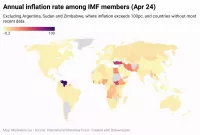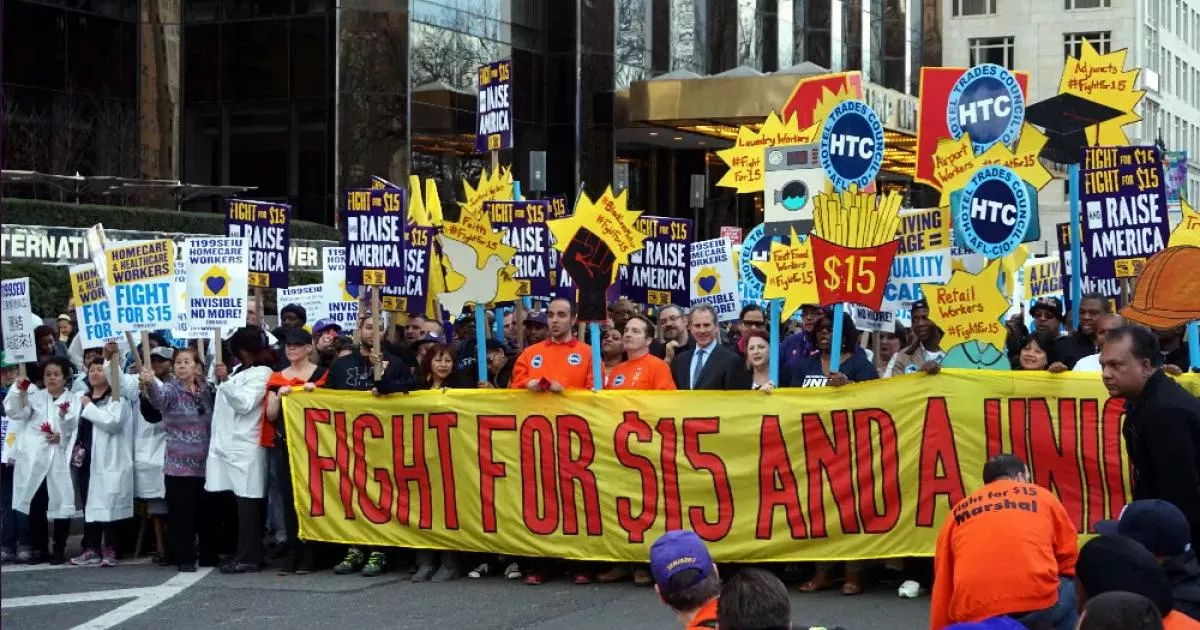A minimum wage is the legally mandated lowest amount employers can pay employees. Most countries have minimum wage laws. Because it increases labor costs, businesses may respond by using gig workers, relocating to areas with lower wages, or automating tasks. Minimum wage policies vary widely by country, region, sector, and age, reflecting differences in cost of living, economic conditions, and industry factors.
1909: Minimum Wage in the United Kingdom
In 1909, the United Kingdom enacted modern national minimum wages following the government recognition of unions.
1933: First Federal Minimum Wage Instituted in the US
In 1933, President Franklin D. Roosevelt signed the National Industrial Recovery Act into law, which instituted the first federal minimum wage in the United States. However, it was later deemed unconstitutional.
1938: Fair Labor Standards Act Establishes Minimum Wage
In 1938, the Fair Labor Standards Act established the minimum wage at 25¢ an hour ($5.58 in 2024) in the United States.
1938: Minimum Wage Introduced in the United States
In 1938, the United States first introduced statutory minimum wages nationally.
1948: Minimum Wage Policy in India
In 1948, India introduced minimum wage policy in its law as one of the first developing countries.
1949: George Stigler's Argument on Minimum Wage
In 1949, George Stigler argued that the minimum wage was ineffective at reducing poverty.
1963: Introduction of Minimum Wage in Spain
In 1963, Spain introduced the minimum wage through Decree 55/1963, an initiative by Jesús Romeo Gorría, the Minister of Labor. The aim was to ensure fair worker remuneration based on labor and economic conditions, promoting salary equity. The initial minimum wage was set at 1,800 pesetas/month, equivalent to approximately 10.80 euros at the time.
1968: Peak Purchasing Power of Minimum Wage
In 1968, the minimum wage in the United States reached its peak purchasing power, standing at $1.60 ($14.00 in 2024).
1975: Minimum Wage Increase After Franco's Death
In 1975, following the death of Franco, the minimum wage in Spain increased to 50.49 euros (8,400 pesetas), equivalent to 657.23 euros in today's currency.
1976: Edward Gramlich's Findings on Minimum Wage
In 1976, Edward Gramlich found that minimum wage benefits often went to higher-income families and negatively impacted teenagers through unemployment.
1978: Economists agreed on minimum wage increases unemployment among low-skilled workers.
According to a 1978 article in the American Economic Review, 90% of the economists surveyed agreed that the minimum wage increases unemployment among low-skilled workers.
1981: Minimum Wage Value Declines
Since 1981, the real (i.e., inflation-adjusted) value of the minimum wage was declining, because it had not increased since then.
1983: Brown et al.'s Study on Minimum Wage Effects
In 1983, Brown et al. noted that a 10 percent increase in the minimum wage correlated with a 1–3 percent decrease in teenage employment, but found no change in the teenage unemployment rate.
1986: Data Used to Update Brown et al.'s Research
Data through 1986 was used to update Brown et al.'s research to provide new estimates encompassing a period when the real value of the minimum wage was declining.
1986: President Reagan described EITC as "the best anti-poverty, the best pro-family, the best job creation measure."
In 1986, President Reagan described the EITC as "the best anti-poverty, the best pro-family, the best job creation measure to come out of Congress."
December 31, 1986: Enactment of the Minimum Wage Act in South Korea
The South Korean government enacted the Minimum Wage Act on December 31, 1986.
January 1, 1988: Minimum Wage System began in South Korea.
The Minimum Wage System began on January 1, 1988.
1988: Minimum Wage Rise in California
Card and Krueger looked at the 1988 rise in California's minimum wage.
1990: Federal Minimum Wage Increases
Card and Krueger looked at the 1990–91 increases in the federal minimum wage.
1990: Survey showed that 62% of academic economists agreed minimum wage increases unemployment.
The authors of the 2000 study also reweighted data from a 1990 sample to show that at that time 62% of academic economists agreed with the statement that minimum wage increases unemployment among low-skilled workers, while 20% agreed with provisos and 18% disagreed.
1991: Wellington's Updated Research on Minimum Wage
In 1991, Wellington's updated research found that a 10% increase in the minimum wage decreased teenage employment by 0.6%, with no effect on teen or young adult unemployment rates.
April 1992: Minimum Wage Increase in New Jersey
In April 1992, the minimum wage in New Jersey increased from $4.25 to $5.05 per hour.
December 1992: Card and Krueger's Survey on Fast Food Restaurants
In November–December 1992, Card and Krueger surveyed employers in New Jersey and eastern Pennsylvania, concluding that the minimum wage increase in New Jersey slightly increased employment in restaurants.
1992: Survey found 79% of economists agreed minimum wage increases unemployment.
By 1992 the survey found 79% of economists in agreement with that statement, that the minimum wage increases unemployment among low-skilled workers.
1992: Minimum Wage Increase in New Jersey
Card and Krueger looked at the 1992 increase in New Jersey's minimum wage.
1994: Start of Effective Minimum Wage Data
In 1994, data on effective minimum wages became available.
1995: Card and Krueger's Book on Minimum Wage
In 1995, Card and Krueger argued that the negative employment effects of minimum wage laws are minimal if not non-existent in their book Myth and Measurement: The New Economics of the Minimum Wage.
1995: Card and Krueger on Publication Bias
In 1995, Card and Krueger noted evidence of publication bias in time-series studies on minimum wages, which favored studies showing negative employment effects.
1995: Emergence of national minimum wage in Armenia.
In 1995, the concept of the national minimum wage emerged in Armenia.
1996: Neumark and Wascher Reexamine Card and Krueger's Results
In 1996, David Neumark and William Wascher reexamined Card and Krueger's results, reporting that minimum wage increases led to decreases in employment.
1996: Fuchs et al. polled labor economists.
Surveys of labor economists have found a sharp split on the minimum wage. Fuchs et al. (1998) polled labor economists at the top 40 research universities in the United States on a variety of questions in the summer of 1996. Their 65 respondents were nearly evenly divided when asked if the minimum wage should be increased.
1997: UK Study on Minimum Wage
A 2012 UK study (1997-2007) found the minimum wage reduced wage inequality and had neutral to positive effects on employment.
1998: Minimum Wage Reintroduced and Expanded in the United Kingdom
In 1998, the minimum wages were reintroduced and expanded in the United Kingdom.
1998: Fuchs et al. polled labor economists.
Surveys of labor economists have found a sharp split on the minimum wage. Fuchs et al. (1998) polled labor economists at the top 40 research universities in the United States on a variety of questions in the summer of 1996. Their 65 respondents were nearly evenly divided when asked if the minimum wage should be increased.
1999: Introduction of minimum wage in the UK
In 1999, the minimum wage was introduced in the UK, facing strong opposition from the business community and the Conservative Party.
1999: Beginning of longest unchanged streak of the national minimum wage in Armenia.
The longest unchanged streak of the national minimum wage in Armenia was between 1999 and 2003, when it was set at 5,000 AMD.
April 2000: Introduction of national minimum wage of €5.58 per hour.
As of April 2000, the government introduced a national minimum wage of €5.58 per hour.
April 2000: Introduction of national minimum wage in Republic of Ireland
The national minimum wage was introduced in the Republic of Ireland in April 2000. Prior to this, minimum wages were set by industry-specific Joint Labour Committees, however, coverage for workers was low and the agreements were poorly enforced and moreover, those who were covered by agreements received low wages.
2000: Survey found 74% of economists agreed minimum wage increases unemployment with provisos
By 2000, 46% of economists were in full agreement and 28% agreed with provisos that minimum wage increases unemployment among low-skilled workers.
2000: Card and Krueger Rebut Neumark and Wascher's Conclusions
In 2000, Card and Krueger rebutted Neumark and Wascher's conclusions in a paper.
2000: Conservatives reversed minimum wage opposition in the UK
In 2000, the Conservative Party in the UK reversed its opposition to the minimum wage, which had been introduced in 1999.
2001: Empirical Study on Minimum Wages and Training
A 2001 empirical study found that there is "no evidence that minimum wages reduce training, and little evidence that they tend to increase training."
2001: Largest increase since 2001.
The minimum wage committee decided to raise the minimum wage in 2018 by 16.4% from the previous year to 7,530 won (US$7.03) per hour. This is the largest increase since 2001 when it was increased by 16.8%.
2003: End of longest unchanged streak of the national minimum wage in Armenia.
The longest unchanged streak of the national minimum wage in Armenia was between 1999 and 2003, when it was set at 5,000 AMD.
2004: Minimum Wage Increase in Florida
In 2004, voters in Florida approved an increase in the minimum wage, followed by a study confirming a strong economy with increased employment.
2005: Study on Publication Bias and Minimum Wage
A 2005 study by T.D. Stanley confirmed publication bias and suggested no clear link between the minimum wage and unemployment.
2006: Robert Whaples survey of AEA members on minimum wage
A 2006 survey by Robert Whaples polled PhD members of the American Economic Association (AEA). 47% of respondents wanted the minimum wage eliminated, 38% supported an increase, 14% wanted it kept at the current level, and 1% wanted it decreased.
2006: Study start date on minimum wage and suicide rates
A 2019 study published in the American Journal of Preventive Medicine covered all 50 states for the years 2006 to 2016 on the effects of the minimum wage on suicide rates.
2006: ILO on minimum wage and unemployment
In 2006, the International Labour Organization (ILO) argued that there was no direct link between the minimum wage and unemployment in countries that had experienced job losses.
July 2007: Minimum wage reached €8.65 per hour.
The minimum wage increased regularly in the period from 2000 to July 2007 and reached €8.65 per hour.
2007: University of New Hampshire Survey Center survey on minimum wage
A 2007 survey conducted by the University of New Hampshire Survey Center found that 73% of labor economists surveyed in the United States believed 150% of the then-current minimum wage would result in employment losses and 68% believed a mandated minimum wage would cause an increase in hiring of workers with greater skills.
2007: UK Study on Minimum Wage
A 2012 UK study (1997-2007) found the minimum wage reduced wage inequality and had neutral to positive effects on employment.
2007: Klein and Dompe survey of minimum wage supporters
In 2007, Klein and Dompe conducted a non-anonymous survey of supporters of the minimum wage who had signed the "Raise the Minimum Wage" statement published by the Economic Policy Institute. The survey found that a majority signed on the grounds that it transferred income from employers to workers, or equalized bargaining power between them in the labor market.
2007: Fair Minimum Wage Act
In 2007, the Fair Minimum Wage Act was introduced.
2007: Report on EITC monetary benefits to the poor.
The ability of the earned income tax credit to deliver larger monetary benefits to the poor workers than an increase in the minimum wage and at a lower cost to society was documented in a 2007 report by the Congressional Budget Office.
2008: Meta-Analysis on Minimum Wages and Employment
A 2008 meta-analysis by Doucouliagos and Stanley supported Card and Krueger's findings, showing little to no negative association between minimum wages and employment.
2008: Global economic downturn hit the country.
As the global economic downturn hit the country in 2008, there was no further wage increases until 2016.
2009: Congress Increases Minimum Wage
In 2009, Congress increased the minimum wage in the United States to $7.25 per hour through the Fair Minimum Wage Act of 2007.
2009: Fair Work Act Establishes Expert Panel
In Australia, the Fair Work Act 2009 established an Expert Panel responsible for maintaining a fair minimum wage safety net. The Expert panel consists of members with experience in workplace relations, economics, social policy or business, industry and commerce.
2009: Fair Work Act Considerations for Minimum Wage
The Fair Work Act 2009 requires the Expert Panel to consider the economy's state, including inflation and business competitiveness, and social goals, like social inclusion and the standard of living for the low paid when setting minimum wages.
April 2010: OECD report on teen unemployment
In April 2010, the Organisation for Economic Co-operation and Development (OECD) released a report suggesting that countries could reduce teen unemployment by lowering the cost of employing low-skilled youth through a sub-minimum training wage.
2010: Study on UK Minimum Wage and Price Increases
A 2010 study on the UK minimum wage found that it did not cause immediate price increases but led to faster price rises in sectors with many low-wage workers over the long term.
2011: Study on Employment Effects for Restaurants
A 2011 paper showed positive employment effects for small restaurants but negative effects for large fast-food chains.
2011: Study on Minimum Wage and Employment Impact
A 2011 study by Baskaya and Rubinstein found that federal minimum wage increases negatively impacted employment, particularly among teenagers.
2012: Study on Adverse Effects on Low-Skilled Employment
A 2012 study by Sabia, Hansen, and Burkhauser found substantial adverse effects on low-skilled employment, particularly among young workers.
2012: UK Studies on Minimum Wage Effects
In 2012, a UK study found the minimum wage reduced wage inequality and had neutral to positive effects on employment and another UK study found no "spill-over" effects from the minimum wage on higher-earning brackets.
December 2013: The Economist on Minimum Wage
In December 2013, The Economist suggested that a minimum wage, if not set too high, could boost pay without harming jobs, noting that high minimum wages can negatively impact employment in rigid labor markets.
2013: Study on Minimum Wage Effects in China
A 2013 study by Fang and Lin found significant adverse effects on employment in China, particularly among women, young adults, and low-skilled workers.
2013: Study on Employment Change and Minimum Wage
A 2013 study published in the Science Direct journal describes that there is not a significant employment change due to increases in minimum wage.
2013: Survey of economics professors on minimum wage impact
In 2013, a diverse group of 37 economics professors was surveyed on their view of the minimum wage's impact on employment. 34% of respondents agreed that raising the federal minimum wage to $9 per hour would make it noticeably harder for low-skilled workers to find employment.
2014: Analysis on Minimum Wage and Teenage Employment
A 2014 analysis found that minimum wage reduces employment among teenagers.
2014: Seattle business owners consider holding off on expansions
In 2014, in Seattle, Washington, some liberal and progressive business owners who had supported the city's new $15 minimum wage considered holding off on expanding their businesses due to the uncertain timescale of the wage increase implementation.
2014: Supporters cited job creation study and news reports.
In 2014, supporters of minimum wage cited a study that found that job creation within the United States is faster in states that raised their minimum wages and news organizations who reported the state with the highest minimum-wage garnered more job creation than the rest of the United States.
January 2015: Introduction of minimum wage legislation in Germany.
In January 2015, Germany introduced minimum wage legislation. While fears of increased unemployment did not materialize, some sectors and regions experienced a decline in job opportunities for temporary and part-time workers.
2015: Beginning of second longest unchanged streak of the national minimum wage in Armenia.
The second longest unchanged streak of the national minimum wage in Armenia was between 2015 and 2019 where it was set at 55,000 AMD.
2016: US Study on Minimum Wage and Wage Inequality
A 2016 US study associated the minimum wage with reduced wage inequality and possible spill-over effects.
2016: Study end date on minimum wage and suicide rates
A 2019 study published in the American Journal of Preventive Medicine covered all 50 states for the years 2006 to 2016 on the effects of the minimum wage on suicide rates.
2016: Start year for McDonalds minimum wage study
A 2021 study that covered 10,000 McDonald's restaurants in the US found that between 2016 and 2020, the cost of 10% minimum wage increases for McDonald's workers were passed through to customers as 1.4% increases in the price of a Big Mac.
2016: Minimum wage was increased to 9.15.
As the global economic downturn hit the country in 2008, there was no further wage increases until 2016 when the minimum wage was increased to 9.15.
2016: Minimum Wage Review Finds Moderate Increases Do Not Inhibit Workplace Participation
In 2016, the annual minimum wage review decisions found that moderate increases to minimum wages do not inhibit workplace participation or result in disemployment.
2017: Study on Minimum Wage in Seattle
A 2017 study in Seattle found that increasing the minimum wage to $13 per hour led to reduced income for low-wage workers due to decreased hours worked.
2017: Minimum Wage Increase Analyzed by BCE
In 2017, a minimum wage increase was implemented in Spain, the impact of which was later analyzed by the BCE in 2019.
2017: Minimum Wage Review Finds Moderate Increases Do Not Inhibit Workplace Participation
In 2017, the annual minimum wage review decisions found that moderate increases to minimum wages do not inhibit workplace participation or result in disemployment.
2017: Minimum Wage in Mumbai
In Mumbai, as of 2017, the minimum wage was Rs. 348/day.
2018: Study on Minimum Wages and Job Impact
A 2018 study published by the University of California discusses that minimum wages actually cause fewer jobs for low-skilled workers, while redistributing GDP to high academia jobs.
2018: Minimum Wage Review Delivers 3% Increase
In 2018, the annual minimum wage review decisions delivered a minimum wage increase of 3% when the corresponding headline rate of inflation was 1.3%.
2018: Previous Minimum Wage Set
In 2018, the minimum wage was 735.90 euros.
2018: Minimum wage increase by 16.4% in South Korea.
The minimum wage committee decided to raise the minimum wage in 2018 by 16.4% from the previous year to 7,530 won (US$7.03) per hour.
May 2019: Effective Nationwide Minimum Wage
In May 2019, the effective nationwide minimum wage in the US, defined as the wage earned by the average minimum-wage worker, was $11.80, the highest since 1994.
August 2019: Lebanese financial crisis began.
Lebanon as of 2021 is ranking as one of the 10 countries in the world with the lowest minimum wages because of the collapse of the local pound following the Lebanese financial crisis that started in August 2019.
2019: Paper on Minimum Wage Effects
A 2019 paper in the Quarterly Journal of Economics argued that job losses in studies are driven by unrealistic assumptions and that minimum wage effects are more complex.
2019: Study on Minimum Wage Increases in Arizona
A 2019 study in Arizona suggested that smaller minimum wage increases might lead to slight economic growth without significantly distorting labor markets.
2019: Study on Minimum Wage and Low-Wage Jobs
A 2019 study in the Quarterly Journal of Economics found that minimum wage increases did not impact the overall number of low-wage jobs but found disemployment in 'tradable' sectors.
2019: Minimum wage increase linked to suicide rate decline
A 2019 study published in the American Journal of Preventive Medicine showed that in the United States, states that implemented a higher minimum wage saw a decline in the growth of suicide rates. The researchers found that for every one dollar increase, the annual suicide growth rate fell by 1.9%.
2019: Arindrajit Dube review of minimum wage research
According to a 2019 review of the academic literature by Arindrajit Dube, research from the US, UK, and other developed countries points to a muted effect of minimum wages on employment, while significantly increasing the earnings of low-paid workers.
2019: Sub-minimum wage rates abolished.
Before the 2019, there existed specific categories of employees that earned sub-minimum wage rates, expressed as a percentage of the full rate of pay. This framework has since been abolished in place of a framework based on the age of the employee.
2019: Percentage of Americans Earning Federal Minimum Wage
In 2019, approximately 1% of workers in the United States earned no more than the federal minimum wage. A large percentage of them worked in the leisure and hospitality industries, where many workers received tips in addition to their hourly wages.
2019: Economists' Findings on Minimum Wage Impacts on Small Businesses
In 2019, economists from Georgia Tech found that minimum wage increases could harm small businesses by increasing bankruptcy rates and reducing hiring.
2019: FWC Constrained in Setting Minimum Wages
In 2019, the FWC was considerably more constrained in setting minimum wages due to uncertain economic conditions during the COVID-19 pandemic.
2019: Congressional Budget Office Report on Federal Minimum Wage
The Congressional Budget Office's 2019 report on a proposed $15 federal minimum wage predicted modest improvements in take-home pay for those who retained employment but warned of potential job losses.
2019: End of second longest unchanged streak of the national minimum wage in Armenia.
The second longest unchanged streak of the national minimum wage in Armenia was between 2015 and 2019 where it was set at 55,000 AMD.
January 2020: Most Americans Earned More Than Minimum Wage
In January 2020, nearly 90% of Americans earning minimum wage made more than the set minimum per hour.
2020: US study on grocery store minimum wage increase and prices
According to a 2020 US study, the cost of 10% minimum wage increases for grocery store workers was fully passed through to consumers as 0.4% higher grocery prices.
2020: FWC Constrained in Setting Minimum Wages
In 2020, the FWC was considerably more constrained in setting minimum wages due to uncertain economic conditions during the COVID-19 pandemic.
2021: US study on McDonald's minimum wage increase and Big Mac prices
A 2021 study found that between 2016 and 2020, the cost of 10% minimum wage increases for McDonald's workers in the US were passed through to customers as 1.4% increases in the price of a Big Mac.
2021: Study on Germany's Minimum Wage
A 2021 study on Germany's minimum wage found that while wages increased without reducing employment, there were significant structural shifts in the economy.
2021: Study on Minimum Wage, EITC, and Criminal Recidivism
According to a 2021 study titled "The Minimum Wage, EITC, and Criminal Recidivism," a minimum wage increase of $0.50 reduces the probability an ex-incarcerated individual returns to prison within 3 years by 2.15%, mainly from recidivism of property and drug crimes.
2021: Assessment on employment effects of the minimum wage.
According to one 2021 assessment, "there is no consensus on the employment effects of the minimum wage."
2021: Lebanon ranks as one of the 10 countries in the world with the lowest minimum wages.
As of 2021, Lebanon is ranking as one of the 10 countries in the world with the lowest minimum wages because of the collapse of the local pound following the Lebanese financial crisis that started in August 2019.
January 2022: Minimum wage is €10.50.
As of 1 January 2022, the minimum wage is €10.50. Those aged 20 and over are eligible to receive 100 percent of the minimum wage.
August 2022: State Minimum Wages Exceed Federal Minimum
In August 2022, 30 states and the District of Columbia had minimum wages higher than the federal minimum in the United States.
November 2022: Increase of the national minimum wage in Armenia.
In November 2022, the national minimum wage in Armenia was subject to the latest increase. It was set at 75,000 AMD.
2022: Spanish Government Sets Minimum Wage at 1,000 Euros per Month
In 2022, the Spanish government established the minimum wage at 33.33 euros per day or 1,000 euros per month, effective from January 1. This decision in 2022 marked a 47% increase from the 735.90 euros minimum wage set in 2018.
2022: Debate on Minimum Wage and Inflation
In 2022, the minimum wage increase sparked debate about its relationship with inflation, focusing on its effectiveness in maintaining purchasing power versus contributing to inflationary pressures.
2024: Minimum wage in 1938 Adjusted for Inflation in 2024
In 1938, the Fair Labor Standards Act established the minimum wage at 25¢ an hour, equivalent to $5.58 in 2024
Mentioned in this timeline
McDonald's is an American multinational fast food chain As of...
California is a U S state on the Pacific Coast...
India officially the Republic of India is a South Asian...
Germany officially the Federal Republic of Germany is a Western...
China officially the People's Republic of China PRC is an...

Inflation in economics signifies an increase in the average price...
Trending
7 days ago Waymo self-driving car navigates through active police standoff with passenger onboard, creating tense situation.

1 month ago Aryna Sabalenka aims for first WTA Finals title amid strong competition in Riyadh.

2 months ago Jon Hamm: From Mad Men to a Beloved Actor

7 months ago The Weeknd's Late Night Interview Debut with Fallon, Bart Simpson's Fallon Ignorance.

Steve Nash is a retired Canadian professional basketball player and former head coach of the Brooklyn Nets Renowned for his...

7 months ago Bridget Fonda's weight loss stuns after years away; spotted with Danny Elfman.
Popular
Matt and Ross Duffer known as the Duffer Brothers are...

Candace Owens is an American conservative political commentator and author...

XXXTentacion born Jahseh Dwayne Ricardo Onfroy was a controversial yet...

Ilhan Omar is an American politician currently serving as the...

Tom Cotton is an American politician and Army veteran currently...

Harriet Tubman was a pivotal American abolitionist and social activist...

